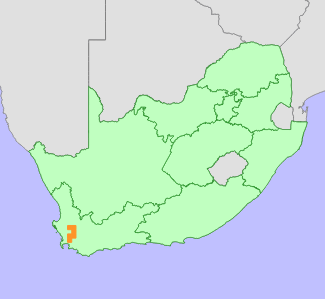|
Scientific Name | Ixia rouxii G.J.Lewis |
Higher Classification | Monocotyledons |
Family | IRIDACEAE |
National Status |
Status and Criteria | Critically Endangered B2ab(i,ii,iii,iv,v) |
Assessment Date | 2015/06/15 |
Assessor(s) | N.A. Helme, R. Koopman, P. Goldblatt & L. von Staden |
Justification | EOO 516 km², AOO <2 km², three small, severely fragmented subpopulations remain after more than 85% habitat loss to urban and agricultural expansion. Population decline continues due to ongoing habitat loss and degradation. |
Distribution |
Endemism | South African endemic |
Provincial distribution | Western Cape |
Range | This species formerly occurred from Porterville to Stellenbosch, but now remains at isolated fragments near Wellington and Wolseley. |
Habitat and Ecology |
Major system | Terrestrial |
Major habitats | Swartland Shale Renosterveld, Boland Granite Fynbos, Swartland Alluvium Fynbos, Breede Alluvium Fynbos |
Description | Alluvial fynbos and renosterveld on lower slopes and flats. |
Threats |
| Less than 15% of this species' lowland habitat remains intact after extensive loss to agricultural and urban expansion. Plants on isolated remnants continue to be threatened by ongoing habitat loss and degradation, particularly unmanaged alien invasive plants and inappropriate fire management. A population was discovered in 2011 during an environmental impact assessment for a proposed development, but due to the high botanical diversity and conservation value of the site, the development plans were altered and is likely to affect only a small part of the population (N.A. Helme pers. comm. 2011). |
Population |
Ixia rouxii is extinct over most of its former range, and until recently was thought possibly extinct as numerous searches in remaining fragments of suitable habitat failed to record any surviving subpopulations. However, three small subpopulations have been found on isolated remnants of lowland fynbos and renosterveld. About 500 plants remain on a 44 ha fragment in the Breede River Valley near Wolseley. A second subpopulation of about 50 mature individuals was discovered in 2008 on a 7 ha fragment on the outskirts of Wellington. In 2011, more plants were found in recently burnt granite fynbos on the lower slopes of the Paardeberg, north-west of Wellington. This species was last recorded near Stellenbosch in 1991, and is possibly locally extinct in this area.
|
Population trend | Decreasing |
Assessment History |
Taxon assessed |
Status and Criteria |
Citation/Red List version | | Ixia rouxii G.J.Lewis | Critically Endangered (Possibly Extinct) | 2011.1 | | Ixia rouxii G.J.Lewis | Critically Endangered (Possibly Extinct) | Raimondo et al. (2009) | | Ixia rouxii G.J.Lewis | Insufficiently Known | Hilton-Taylor (1996) | | Ixia rouxii G.J.Lewis | Uncertain | Hall et al. (1980) | |
Bibliography |
De Vos, M.P. 1999. Ixia. In: O.A. Leistner (ed). Flora of Southern Africa 7 Iridaceae Part 2: Ixioideae, Fascicle 1: Ixieae:3-87. National Botanical Institute, Pretoria.
Goldblatt, P. and Manning, J.C. 2000. Cape Plants: A conspectus of the Cape Flora of South Africa. Strelitzia 9. National Botanical Institute, Cape Town.
Goldblatt, P. and Manning, J.C. 2016. Systematics of the southern African genus Ixia L. (Iridaceae): 5. Synopsis of section Ixia, including five new species. South African Journal of Botany 104:175-198.
Hall, A.V., De Winter, M., De Winter, B. and Van Oosterhout, S.A.M. 1980. Threatened plants of southern Africa. South African National Scienctific Programmes Report 45. CSIR, Pretoria.
Hilton-Taylor, C. 1996. Red data list of southern African plants. Strelitzia 4. South African National Botanical Institute, Pretoria.
Lewis, G.J. 1962. South African Iridaceae. The genus Ixia. Journal of South African Botany 28:45-195.
Raimondo, D., von Staden, L., Foden, W., Victor, J.E., Helme, N.A., Turner, R.C., Kamundi, D.A. and Manyama, P.A. 2009. Red List of South African Plants. Strelitzia 25. South African National Biodiversity Institute, Pretoria.
|
Citation |
| Helme, N.A., Koopman, R., Goldblatt, P. & von Staden, L. 2015. Ixia rouxii G.J.Lewis. National Assessment: Red List of South African Plants version 2024.1. Accessed on 2025/11/19 |
 Comment on this assessment
Comment on this assessment


